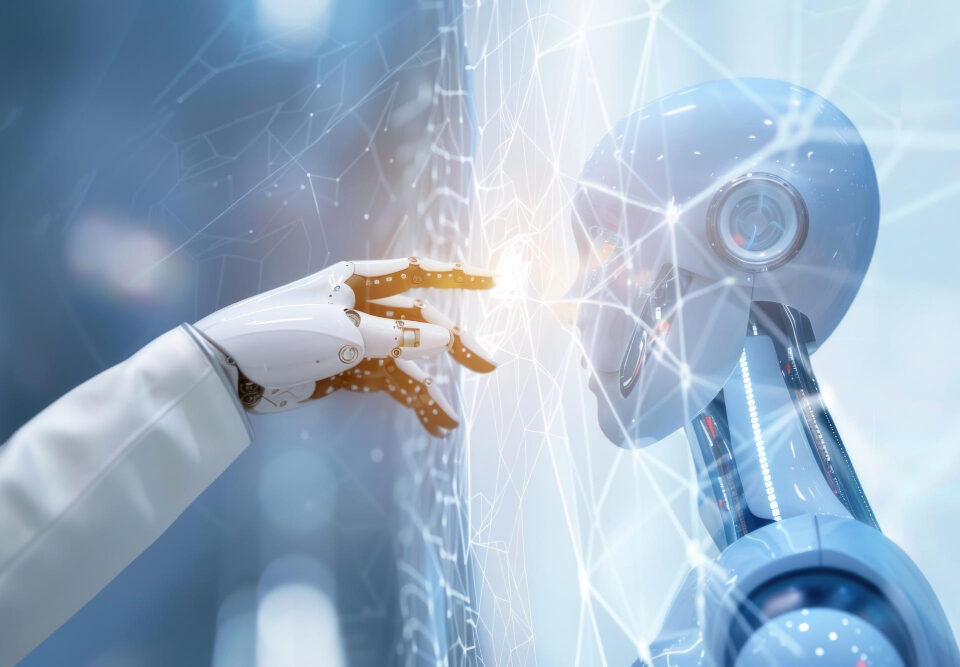- Mail:
- info@digital4pro.com
Le sfide organizzative nell’implementazione dell’intelligenza artificiale in azienda

IoT: LoRa e LoRaWAN
30 Luglio 2025
Il Service Climate: Clima organizzativo
12 Agosto 2025Introduzione
Sebbene l’adozione dell’intelligenza artificiale, combinata ad altre tecnologie come i big data, possa apportare significativi vantaggi dal punto di vista organizzativo fino ad alimentare il vantaggio competitivo aziendale, esistono anche alcune sfide da fronteggiare durante la fase della sua implementazione. Queste ultime sono particolarmente rilevanti e necessitano di essere affrontate adeguatamente, poiché altrimenti le organizzazioni non riescono a cogliere i benefici che questa tecnologia può generare.
Nello specifico, le principali sfide organizzative che devono essere fronteggiate in questo processo sono le seguenti:
- Sostenere le significative spese necessarie per introdurre l’AI all’interno delle aziende;
- Integrare la nuova tecnologia con la struttura IT già presente nell’organizzazione.
Sostenere le significative spese necessarie per introdurre l’AI all’interno delle aziende
Le organizzazioni stanno progressivamente investendo risorse economiche su questa tecnologia. Per determinare icosti medi che sono richiesti da un progetto di questo tipo, si prende come riferimento lo studio condotto da WebFX,società statunitense esperta di marketing[1].
A tal proposito, occorre effettuare una distinzione tra due principali soluzioni a disposizione delle organizzazioni:
- Sviluppo interno di un software di intelligenza artificiale: questa alternativa ha un costo di sviluppo e di installazione che può variare, a seconda dei casi, da 6000 a 300 000 dollari. In particolare, i costi variano a seconda del progetto che si intende Per esempio, le tariffe per la creazione di un sistema dichatbot partono da 6000 dollari, mentre quelle per la realizzazione di un sistema di analisi dei dati da circa 35 000. Oltre a ciò, occorre considerare anche i costi di gestione legati a questa soluzione. Qui vi rientrano le spese per le assunzioni, per i salari e per i benefit di tutti i membri del team deputato allo sviluppo, alla gestione e all’aggiornamento di queste soluzioni tecnologiche. In questo senso, si può dire che il salario medio di un data scientist si aggira intorno ai 94 000 dollari all’anno, mentre quello di uno sviluppatore è pari acirca 80 000 dollari annuali;
- Acquisizione dall’esterno di un software realizzato da una società specializzata: in questo caso invece il costo medio raggiunge un valore massimo di circa 40 000 dollari all’anno. Per esempio, i canoni mensili per un sistema di chatbot possono variare da 100 a 1500 dollari a seconda della soluzione scelta. Passando ai costi di gestione, si può dire che in questo caso vengono meno le spese per le assunzioni e gli stipendi citati nell’altra soluzione. In genere, questa alternativa prevede delle tariffe mensili da corrispondere al partner, che variano in funzione del servizio che viene
Dai dati riportati si comprende come, generalmente, lo sviluppo interno di software basati sull’intelligenza artificiale comporta costi maggiori rispetto all’acquisto dall’esterno di soluzioni già pronte. Allo stesso tempo però, questatecnica permette di far nascere talenti interni specializzati in questo campo, che hanno la possibilità, vista la maggioreconoscenza dell’organizzazione in cui operano, di dar vita a sistemi personalizzati in funzione delle esigenze aziendali.
A livello complessivo, è possibile individuare la tendenza secondo cui le imprese investono significativamente sull’intelligenza artificiale. Infatti, secondo alcuni studi[2], nel 2020 esse hanno speso oltre 50 miliardi di dollari in progetti di questo tipo. Tuttavia, soltanto il 10% delle aziende che hanno investito in questo campo ha ottenuto significativi benefici dal punto di vista economico-finanziario[3]. Ciò significa che non sempre gli investimenti sull’intelligenza artificiale conducono ai risultati desiderati. Questo potrebbe essere dovuto ad alcuni errori commessinella definizione di una strategia per l’implementazione di questa tecnologia. Inoltre, è opportuno aggiungere chealcune organizzazioni sono andate incontro anche a fallimenti significativi. Un esempio importante in questo senso è fornito dal caso IBM, che ha investito circa 60 milioni di dollari su un progetto oncologico basato sull’intelligenza artificiale che forniva suggerimenti non accurati in merito al trattamento del cancro.
Per chiudere questa prima analisi, si può affermare che entrambe le soluzioni descritte impongono alleorganizzazioni di sostenere dei costi significativi. Di conseguenza, nonostante tutti i benefici che l’intelligenza artificiale può apportare e che sono stati descritti nel corso dell’elaborato, è possibile che alcune aziende scelgano dinon investire in questa tecnologia a causa del dispendio di risorse economiche richiesto. In più, come è stato sottolineato, non sempre questi progetti comportano dei vantaggi di natura economica. Per cui anche questo aspetto può essere un fattore che allontana le organizzazioni dall’intelligenza artificiale.
Integrare la nuova tecnologia con la struttura IT già presente nell’organizzazione
La seconda sfida organizzativa riguarda l’integrazione dell’intelligenza artificiale nell’infrastruttura IT già attiva all’interno delle aziende, che comprende tutti quei componenti che consentono il funzionamento degli strumenti tecnologici utilizzati dall’impresa. Questo processo è particolarmente complesso e rappresenta una delle ragioni principali alla base dei fallimenti nell’implementazione di questa tecnologia[4]. In questo senso, è importante che le organizzazioni si focalizzino su come inserire e connettere l’intelligenza artificiale alle strutture IT già adottate, qualihardware e software.
A tal proposito, è opportuno programmare queste soluzioni integrandole fin da subito all’ambiente tecnologico dell’organizzazione, secondo una tecnica chiamata “AI Operations”[5]. Quest’ultima è una pratica che prevede la costruzione, l’integrazione, il collaudo, il lancio e la gestione del sistema di intelligenza artificiale con le altre strutturetecnologiche organizzative, in modo tale da creare un ambiente tecnologico coerente.
Talvolta invece le aziende si concentrano esclusivamente sulla progettazione delle macchine intelligenti. Tuttavia, se queste non vengono combinate adeguatamente con i sistemi tecnologici già utilizzati non possono apportare alcunvantaggio dal punto di vista organizzativo. Per condurre questa attività nella maniera corretta è necessario che leorganizzazioni abbiano a loro disposizione ingegneri e programmatori specializzati sul tema. Soltanto grazie a queste figure, l’intelligenza artificiale può essere integrata con le altre strutture IT attive, può fornire le intuizioni desiderate ai lavoratori e può essere portata alla scala ideale.
Nello specifico, l’introduzione di questo strumento avviene in maniera corretta se l’ambiente tecnologico che ne risulta presenta le seguenti tre caratteristiche fondamentali[6]:
- Affidabilità: talvolta, i sistemi di intelligenza artificiale possono presentare problematiche di natura tecnica, come per esempio quando vengono istruiti con dati sbagliati, oppure quando diminuiscono la loro velocità di È importante evitare queste criticità per rendere l’infrastruttura IT affidabile. In questo senso, una soluzione puòessere quella di sviluppare delle idonee architetture di elaborazione e di archiviazione, che sono in grado di risolvere le problematiche di latenza e di capacità di trasmissione;
- Flessibilità: per supportare le organizzazioni nel dinamico contesto competitivo attuale, è opportuno che i dati vengano importati nelle macchine intelligenti a intervalli regolari, con frequenti aggiornamenti;
- Scalabilità: quando il business aziendale si espande, anche le capacità e le competenze tecnologiche dovrebbero evolvere. Tuttavia, le diverse strutture IT delle organizzazioni potrebbero crescere in maniera differente e questo può generare delle problematiche. In questo caso, il team IT dell’azienda svolge un ruolo cruciale perché ha il compito di aggiustare e testare costantemente le nuove soluzioni con il sistemapreesistente, in maniera tale da trovare il giusto
Dall’analisi effettuata si comprende quindi come l’intelligenza artificiale non sia una tecnologia che può essereintrodotta all’interno delle organizzazioni senza un’adeguata pianificazione. La sua implementazione richiede una certa progettualità, necessaria per determinare in anticipo le modalità con cui questa deve essere combinata con le altre strutture tecnologiche aziendali. Se non si presta attenzione a questo aspetto, le macchine intelligenti risultano scollegate e separate rispetto al resto dell’architettura IT organizzativa e pertanto non riescono a produrre gli effettidesiderati.
Conclusioni
Per concludere, si afferma nuovamente che la combinazione tra intelligenza artificiale e big data può essere particolarmente vantaggiosa dal punto di vista organizzativo.
Ciò è dovuto alle seguenti due motivazioni principali:
- I sistemi di intelligenza artificiale sono gli unici, allo stato attuale, in grado di raccogliere e analizzare grandiquantità di dati in modo efficace e tempestivo;
- I big data hanno rappresentato e continuano a rappresentare lo strumento principale per addestrare lemacchine
È stato dimostrato come l’intelligenza artificiale sia capace di alimentare il vantaggio competitivo aziendale, in quanto consente di ottenere delle performance superiori rispetto ai competitors, che si traducono sia in maggiori ricavi che in minori costi nelle varie aree organizzative in cui essa può essere impiegata.
Nello specifico, i vantaggi principali correlati all’implementazione di questa tecnologia sono:
- Miglioramento nell’accuratezza delle previsioni;
- Incremento dell’efficienza;
- Ottimizzazione delle scelte effettuate in tempo reale.
Nonostante tutti gli aspetti positivi fin qui descritti, sono state poi delineate anche le principali sfide organizzative che le aziende devono fronteggiare nel momento in cui desiderano approcciarsi all’intelligenza artificiale. In particolare, si fa riferimento sia ai costi necessari per l’introduzione di questa tecnologia che alle difficoltà correlate nell’integrazione di questo strumento con l’infrastruttura IT preesistente. Queste sfide richiedono un grade dispendio di tempo e di risorse economiche. Pertanto, soltanto le organizzazioni che pianificano una strategia adeguata riescono a superarle in maniera efficace e a ottenere dall’intelligenza artificiale tutti i vantaggi che sono stati descritti.
Bibliografia
- Agrawal, A., Gans, J., & Goldfarb, A. (2017). The trade-off every AI company will face.
- Harvard Business Review Digital Articles.
- Aspan, M. (2020). Siri, Did I Ace the Interview? Fortune International (Europe), 181(2).
- Bhimani, A., & Willcocks, L. (2014). Digitisation, Big Data and the transformation of accounting information. Accounting and Business Research, Taylor & Francis, Vol. 44 No. 4.
- Brundage, M., Avin, S., Clark, J., Toner, H., Eckersley, P., Garfinkel, B., … & Amodei, D. (2018). The malicious use of artificial intelligence: Forecasting, prevention, and mitigation. arXiv preprint arXiv:1802.07228.
- CGMA (2016). Business Analytics And Decision Making. Baseline.
- Costa, G., & Gianecchini, M. (2019). Risorse umane: persone, relazioni e valore (Vol. 454). McGraw-Hill.
- Craigen, D., Diakun-Thibault, N., & Purse, R. (2014). Defining cybersecurity. Technology Innovation Management Review, 4(10).
- Daft, R. L. (2017). Organizzazione aziendale. Sesta edizione. Daft, R. L. (2021). Organizzazione aziendale. Maggioli, Milano.
- Davenport, T., Guha, A., & Grewal, D. (2021). How to Design an AI Marketing Strategy: What the Technology Can Do Today—and What’s Next. Harvard Business Review, 99, 42- 47.
- Davenport, T., Guha, A., Grewal, D., & Bressgott, T. (2020). How artificial intelligence will change the future of marketing. Journal of the Academy of Marketing Science, 48(1), 24- 42.
- Doke, D. (2021). Software AI. Recruiter.
- Forger, G. (2020). AI and IoT are ready for your warehouse. Logistics management (Highlands Ranch, Colo.: 2002).
- Fountaine, T., McCarthy, B., & Saleh, T. (2021). Getting AI to scale. Harvard Business Review.
- Galeotti, M., & Garzella, S. (Eds.). (2013). Governo strategico dell’azienda: Prefazione del Prof. Umberto Bertini. G Giappichelli Editore.
- Gambhir, B., & Bhattacharjee, A. (2021). Embracing the role of artificial intelligence in accounting and finance: contemplating the changing skillset expectations. Development and Learning in Organizations: An International Journal.
- Gregg, M. (2005). CISSP security-management practices. Upper Saddle River, NJ: Pearson Education.
- Haenlein, M., & Kaplan, A. (2019). A brief history of artificial intelligence: On the past, present, and future of artificial intelligence. California management review, 61(4), 5-14.
- Harrison, N., & O’Neill, D. (2017). If your company isn’t good at analytics, it’s not ready for AI. Harvard Business Review.
- Henke, N., Levine, J., & McInerney, P. (2018). You don’t have to be a data scientist to fill this must-have analytics role. Harvard Business Review.
- Huang, M. H., Rust, R., & Maksimovic, V. (2019). The feeling economy: Managing in the next generation of artificial intelligence (AI). California Management Review, 61(4), 43-65.
- Lichtenthaler, U. (2020). Mixing data analytics with intuition: Liverpool Football Club scores with integrated intelligence. Journal of Business Strategy.
- Luo, X., Qin, M. S., Fang, Z., & Qu, Z. (2021). Artificial intelligence coaches for sales agents: Caveats and solutions. Journal of Marketing, 85(2), 14-32.
- McAfee, A., & Brynjolfsson, E. (2012). Big data: the management revolution. Harvard business review, 90(10), 60-68.
- Miyashita, M., & Brady, M. (2019). The Health Care Benefits of Combining Wearables and AI. Harvard Business Review.
- Nair, K., & Gupta, R. (2021). Application of AI technology in modern digital marketing environment. World Journal of Entrepreneurship, Management and Sustainable Development.
- Niehueser, W., & Boak, G. (2020). Introducing artificial intelligence into a human resources function. Industrial and commercial training, 52(2), 121-130.
- Ore, O., & Sposato, M. (2021). Opportunities and risks of artificial intelligence in recruitment and selection. International Journal of Organizational Analysis.
- Paschen, J., Kietzmann, J., & Kietzmann, T. C. (2019). Artificial intelligence (AI) and its implications for market knowledge in B2B marketing. Journal of Business & Industrial Marketing.
- Paschen, U., Pitt, C., & Kietzmann, J. (2020). Artificial intelligence: Building blocks and an innovation typology. Business Horizons, 63(2), 147-155.
- Petkov, R. (2020). Artificial intelligence (AI) and the accounting function—A revisit and a new perspective for developing framework. Journal of emerging technologies in accounting, 17(1), 99-105.
- Pighin, M., & Marzona, A. (2018). Sistemi informativi aziendali: ERP e sistemi di data analysis.
- Poba-Nzaou, P., Galani, M., Uwizeyemungu, S., & Ceric, A. (2021). The impacts of artificial intelligence (AI) on jobs: an industry perspective. Strategic HR Review, 20(2), 60- 65.
- Ponnapalli, P. (2022). Keys to successful innovation through artificial intelligence. Harvard Business Review.
- Ransbotham, S., Candelon, F., Kiron, D., LaFountain, B., & Khodabandeh, S. (2021). The Cultural Benefits of Artificial Intelligence in the Enterprise. MIT Sloan Management Review and Boston Consulting Group.
- Rudko, I., Bashirpour Bonab, A., & Bellini, F. (2021). Organizational structure and artificial intelligence. Modeling the intraorganizational response to the ai contingency. Journal of Theoretical and Applied Electronic Commerce Research, 16(6), 2341-2364.
- Samonas, S., & Coss, D. (2014). The CIA strikes back: Redefining confidentiality, integrity and availability in security. Journal of Information System Security, 10(3).
- Shrestha, Y. R., Ben-Menahem, S. M., & Von Krogh, G. (2019). Organizational decision- making structures in the age of artificial intelligence. California Management
- Review, 61(4), 66-83.
- Simonovich, L. (2021). Balancing AI advances with robust cybersecurity solutions. World Oil.
- Soni, V. D. (2020). Challenges and Solution for Artificial Intelligence in Cybersecurity of the USA. Available at SSRN 3624487.
- Strubell, E., Ganesh, A., & McCallum, A. (2019). Energy and policy considerations for deep learning in NLP. arXiv preprint arXiv:1906.02243.
- Tabesh, P. (2021). Who’s making the decisions? How managers can harness artificial intelligence and remain in charge. Journal of Business Strategy.
- S (2021). 3 areas where AI will boost your competitive advantage. Harvard Business Review Digital Articles.
- Truong, T. C., Zelinka, I., Plucar, J., Čandík, M., & Šulc, V. (2020). Artificial intelligence and cybersecurity: Past, presence, and future. In Artificial intelligence and evolutionary computations in engineering systems (pp. 351-363). Springer, Singapore.
- Tschang, F. T., & Almirall, E. (2021). Artificial intelligence as augmenting automation: Implications for employment. Academy of Management Perspectives, 35(4), 642-659.
- Tse, T., Esposito, M., Takaaki, M., & Goh, D. (2020). The dumb reason your AI project will fail. Harvard business review digital articles, 2-5.
- Vadari, S., & Desik, P. A. (2021). The Role of AI/ML in Enhancing Knowledge Management Systems. IUP Journal of Knowledge Management, 19(2), 7-31.
- Wamba-Taguimdje, S. L., Wamba, S. F., Kamdjoug, J. R. K., & Wanko, C. E. T. (2020). Influence of artificial intelligence (AI) on firm performance: the business value of AI-based transformation projects. Business Process Management Journal, 26(7), 1893-1924.
- Whitmore, A., Agarwal, A., & Da Xu, L. (2015). The Internet of Things—A survey of topics and trends. Information systems frontiers, 17(2), 261-274.
- Yampolskiy, R. V. (2017). AI Is the Future of Cybersecurity, for Better and for Worse. Harvard Business Review. May, 8.
- Zaki, M., McColl-Kennedy, R., & Neely, A. (2021). Using AI to Track How Customers Feel—In Real Time. Harvard Business Review.
- Zhang, H., Zhang, X., & Song, M. (2021). Deploying AI for New Product Development Success: By embracing and incorporating AI in all stages of NPD, companies can increase their success rate of NPD projects. Research-Technology Management, 64(5), 50-57.
- Zouave, E., Gustafsson, T., Bruce, M., Colde, K., Jaitner, M., & Rodhe, I. (2020). Artificially intelligent cyberattacks. Swedish Defence Research Agency, FOI, Tech. Rep. FOI.
- (2017). Lavazza a caccia di “coffe addicted” con l’intelligenza artificiale. Il Sole 24 Ore. Retrieved fromhttps://www.ilsole24ore.com/art/lavazza-caccia-coffee-addicted-l- intelligenza-artificiale–AEBRpxQD 2022/08/02
- Amar, J., Majumder, S., Surak, Z., & von Bismarck, N. (2021). How AI-driven nudges can transform an operation’s performance. McKinsey Global Institute. Retrieved from https://www.mckinsey.com/business-functions/operations/our-insights/how-ai-driven- nudges-can-transform-an-operations-performance 2022/07/27
- Balabio, B., Orlando, P., & Scolari, T. (2021). Cresce il mercato dell’intelligenza artificiale in Italia. Retrieved from https://www.osservatori.net/it/ricerche/comunicati- stampa/artificial-intelligence-italia-mercato-progetti-20202022/07/08
- Berruti, F., Nel, P., & Whiteman R. (2020). An executive primer on artificial general intelligence. McKinsey Global Institute. Retrieved from https://www.mckinsey.com/business-functions/operations/our-insights/an-executive- primer-on-artificial-general-intelligence 2022/07/06
- Boehm, J., Curcio, N., Merrath, P., Shenton, L., & Stahle T. (2019). The risk-based approach to cybersecurity. McKinsey Global Institute. Retrieved from https://www.mckinsey.com/business-functions/risk-and-resilience/our-insights/the-risk- based-approach-to-cybersecurity 2022/08/03
- Brooks, C. (2022). Alarming cyber statistics for mid-year 2022 that you need to know. Forbes. Retrieved from https://www.forbes.com/sites/chuckbrooks/2022/06/03/alarming- cyber-statistics-for-mid-year-2022-that-you-need-to-know/?sh=7043d0247864 2022/08/03
- Brown, S., Gandhi, D., Herring, L., & Puri, A. (2019). The analytics academy: bridging the gap between human and artificial intelligence. McKinsey Global Institute. Retrieved from https://www.mckinsey.com/business-functions/mckinsey-analytics/our-insights/the- analytics-academy-bridging-the-gap-between-human-and-artificial-intelligence 2022/07/18
- Buehler, K., Dooley, R., Grennan, L., & Singla, A. (2021). Getting to know-and manage- your biggest AI risks. McKinsey Global Institute. Retrieved from https://www.mckinsey.com/business-functions/mckinsey-analytics/our-insights/getting-to- know-and-manage-your-biggest-ai-risks 2022/07/11
- Bughin, J., Seong, J., Manyika, J., Chui, M., & Joshi, R. (2018). Notes from the AI frontier: Modeling the impact of AI on the world economy. McKinsey Global Institute. Retrieved from https://www.mckinsey.com/featured-insights/artificial-intelligence/notes-from-the-ai- frontier-modeling-the-impact-of-ai-on-the-world-economy#part12022/07/15
- Chakraborty, A. (2021). A.I. can be a cornerstone of success – but only if leaders make the right choices. Fortune. Retrieved from https://fortune.com/2021/10/27/ai-artificial- intelligence-business-strategy-data-accenture/2022/07/29
- Chui, M., Hall, B., Singla, A., & Sukharevsky, A. (2021). The state of AI in 2021. McKinsey Global Institute. Retrieved from https://www.mckinsey.com/business- functions/quantumblack/our-insights/global-survey-the-state-of-ai-in-20212022/07/08
- Chui, M., Manyika, J., Miremadi, M., Henke, N., Chung, R., Nel, P., & Malhotra, S. (2018). Notes from the AI frontier: Applications and value of deep learning. McKinsey global institute discussion paper, April. Retrieved from https://www.mckinsey.com/featured- insights/artificial-intelligence/notes-from-the-ai-frontier-applications-and-value-of-deep- learning 2022/07/07
- Dandona, G. S., Sharma, J., & Wright, M. (2021). Our own digital journey: upskilling hundreds of McKinsey technologists in AI. McKinsey Global Institute. Retrieved from https://www.mckinsey.com/about-us/new-at-mckinsey-blog/ai-upskilling-for-over-500- firm-technologists 2022/07/19
- Fowler, G. (2020). AI and its potential for cybersecurity. Forbes. Retrieved from https://www.forbes.com/sites/forbesbusinessdevelopmentcouncil/2020/12/18/ai-and-its- potential-for-cybersecurity/?sh=5d2f609e69d9 2022/08/03
- https://assets.siemens-energy.com/siemens/assets/api/uuid:cf20f2e1-ca9c-4589-9f88- 4e6592b4672d/brochure-deeparmour-industrial-200609.pdf 2022/08/05
- https://bids.berkeley.edu/news/berkeley-institute-data-science-and-accenture-applied- intelligence-announce-new-collaboration 2022/07/18
- https://info.algorithmia.com/hubfs/2020/Reports/2021-Trends-in- ML/Algorithmia_2021_enterprise_ML_trends.pdf?hsLang=en-us 2022/07/08
- https://wwd.com/business-news/technology/levis-ai-bootcamp-data-science-1234881378/ 22/09/04
- https://www.accenture.com/_acnmedia/PDF-63/Accenture-CoBE-Brochure-
- pdf#zoom=50 2022/08/23
- https://www.accenture.com/fr-fr/_acnmedia/36dc7f76eab444cab6a7f44017cc3997.pdf 2022/07/08
- https://www.bcg.com/publications/2020/is-your-company-embracing-full-potential-of- artificial-intelligence 2022/09/17
- https://www.capgemini.com/wp-content/uploads/2019/07/AI-in- pdf 2022/08/03
- https://www.careers.ox.ac.uk/article/the-pymetrics-games-overview-and-practice- guidelines 2022/07/26
- https://www.cnr.it/sites/default/files/public/media/attivita/editoria/VOLUME%20FULL%20 14%20digital%20LIGHT.pdf 2022/08/22
- https://www.levistrauss.com/2021/05/17/machine-learning-bootcamp/ 2022/07/19
- https://www.linkedin.com/pulse/how-coca-cola-using-ai-stay-top-soft-drinks-market- shivani-salunkhe 2022/08/23
- https://www.mckinsey.com/about-us/new-at-mckinsey-blog/mckinsey-receives-top- ranking-in-the-forrester-wave-ai-report 2022/07/19
- https://www.nist.gov/system/files/documents/cyberframework/cybersecurity-framework- pdf 2022/08/03
- https://www.statista.com/statistics/1083482/worldwide-ai-revenue-increase/ 2022/08/02 https://www.statista.com/statistics/1083516/worldwide-ai-cost-decrease/ 2022/08/02
- https://www.statista.com/statistics/1119824/global-business-and-hr-leaders-on-ai-impact- to-job-numbers/ 2022/07/20
- https://www.statista.com/statistics/1235395/worldwide-ai-enabled-cyberattacks- companies/ 2022/08/05
- https://www.statista.com/statistics/1293758/ai-marketing-revenue-worldwide/ 2022/07/25
- https://www.statista.com/statistics/472934/business-analytics-software-revenue- worldwide/ 2022/07/29
- https://www.statista.com/statistics/871513/worldwide-data-created/ 2022/07/29
- https://www.statista.com/statistics/941137/ai-investment-and-funding-worldwide/ 2022/07/08
- https://www.treccani.it/enciclopedia/intelligenza-artificiale 2022/07/04
- https://www.treccani.it/enciclopedia/sicurezza-informatica/#:~:text=sicur%C3%A9zza%20inform%C3%A0tica%20Ramo%20dell’informatica,dati%20riservati%20in%20essi%20contenuti. 2022/09/13
- https://www.tripwire.com/state-of-security/security-data-protection/43-billion-stolen- through-business-email-compromise-since-2016-reports-fbi/ 2022/09/13
- https://www.webfx.com/martech/pricing/ai/#:~:text=In%202020%2C%20companies%20can%20pay,house%20or%20freelance%20data%20scientists.&text=In%20comparison
- %2C%20custom%20AI%20solutions,from%20%246000%20to%20over%20%24300%2C 000. 2022/09/18
- Jeans, D. (2020). Companies will spend $50 billion on artificial intelligence this year with little to show for it. Forbes. Retrieved from https://www.forbes.com/sites/davidjeans/2020/10/20/bcg-mit-report-shows-companies- will-spend-50-billion-on-artificial-intelligence-with-few-results/?sh=7efe3fe57c87 2022/09/17
- Johar, P. (2020). How AI makes big data smarter. Forbes. Retrieved from https://www.forbes.com/sites/forbestechcouncil/2020/03/23/how-ai-makes-big-data- smarter/?sh=381f9b6a4684 2022/08/01
- Luchtenberg, D., & Migliorini, R. (2022). Coca-Cola: The people-first story of a digital transformation. McKinsey Global Institute. Retrieved from https://www.mckinsey.com/business-functions/operations/our-insights/coca-cola-the-people-first-story-of-a-digital-transformation 2022/08/02
- Malins, A. (2022). Machine learning and artificial intelligence: implementation in practice. Forbes. Retrieved from https://www.forbes.com/sites/forbestechcouncil/2022/01/25/machine-learning-and- artificial-intelligence-implementation-in-practice/?sh=7692b2a35c89 2022/07/15
- Manyika J., & Sneader K. (2018). AI, automation, and the future of work: Ten things to solve for. McKinsey Global Institute. Retrieved from https://www.mckinsey.com/featured- insights/future-of-work/ai-automation-and-the-future-of-work-ten-things-to-solve-for 2022/07/15
- Marr, B. (2017). The Amazing Ways Coca Cola Uses Artificial Intelligence And Big Data To Drive Success. Forbes. Retrieved from https://www.forbes.com/sites/bernardmarr/2017/09/18/the-amazing-ways-coca-cola- uses-artificial-intelligence-ai-and-big-data-to-drive-success/?sh=1448c01778d2 2022/08/02
- Marr, B. (2018). The amazing ways how Unilever uses artificial intelligence to recruit & train thousands of employees. Forbes. Retrieved from https://www.forbes.com/sites/bernardmarr/2018/12/14/the-amazing-ways-how-unilever-uses-artificial-intelligence-to-recruit-train-thousands-of-employees/?sh=485a1ca76274 2022/07/26
- Marr, B. (2022). The most in – demand technical skills – and how to develop them. Forbes. Retrieved from https://www.forbes.com/sites/bernardmarr/2022/08/03/the-most- in-demand-technical-skills–and-how-to-develop-them/?sh=7a1c4e1362e4 2022/08/22
- Mohan S. (2022). How to make it easier to implement AI in your business. Forbes. Retrieved from https://www.forbes.com/sites/forbestechcouncil/2022/05/27/how-to- make-it-easier-to-implement-ai-in-your-business/?sh=481bfbd65300 2022/07/12
- Rossitto, S. (2021). “Senza intelligenza artificiale e big data impossibile un vaccino contro il Covid in tempi brevi”. Il Sole 24 Ore. Retrieved from https://www.ilsole24ore.com/art/senza-intelligenza-artificiale-e-big-data-impossibile-vaccino-contro-covid-tempi-brevi-AD5lOYHB 2022/08/01
- Rusconi, G. (2022). L’intelligenza artificiale facilita il cambiamento organizzativo. Il Sole 24 Ore. Retrieved from https://www.ilsole24ore.com/art/l-intelligenza-artificiale-facilita- cambiamento-organizzativo-AEitC2OB 2022/07/14
- Sinur, J., & Peters, E. (2019). AI & big data; better together. Forbes. Retrieved from https://www.forbes.com/sites/cognitiveworld/2019/09/30/ai-big-data-better- together/?sh=61a9e9a360b3 2022/08/01
- Taulli, T. (2021). Artificial intelligence: should you teach it to your employees? Forbes. Retrieved from https://www.forbes.com/sites/tomtaulli/2021/09/10/ai-artificial- intelligence-should-you-teach-it-to-your-employees/?sh=2bab6b507b73 2022/07/18
- Tremolada, L. (2019). Machine learning, deep learning e reti neurali. Ecco di cosa parliamo. Il sole 24 ore. Retrieved from https://www.ilsole24ore.com/art/machine- learning-deep-learning-e-reti-neurali-ecco-cosa-parliamo–AEaToEBH2022/07/07
- ASIMOV, I. (1950), I, Robot. (Cited at page 5)
- BABBAGE, C. (1982), «On the Mathematical Powers of the Calculating Engine», The Origins of Digital Computers. Texts and Monographs in Computer Science.
- BODEN, M. A. (2018), Artificial Intelligence: A Very Short Introduction.
- CAMPBELL, M., HOANE, A. J. e HSIUNG HSU, F. (2002), «Deep Blue», Artificial Intelligence, vol. 134, p. 57–83.
- CLARKE, A. C. e KUBRICK, S. (1968), 2001: A Space Odyssey.
- DICK, P. K. (1968), Do Androids Dream of Electric Sheep?
- HASHEMIPOUR, S. e ALI, M. (2020), «Amazon Web Services (AWS) – An Overview of the On-Demand Cloud Computing Platform».
- KRIZHEVSKY, A., SUTSKEVER, I. e HINTON, G. E. (2012), «ImageNet classification with deep convolutional neural networks», Communications of the ACM, vol. 60, p. 84 – 90.
- LECUN, Y., BENGIO, Y. e HINTON, G. E. (2015), «Deep Learning», Nature, vol. 521, p. 436–444.
- MASLEJ, N., FATTORINI, L., BRYNJOLFSSON, E., ETCHEMENDY, J., LIGETT, K., LYONS, T., MANYIKA, J., NGO, H., NIEBLES, J. C., PARLI, V., SHOHAM, Y., WALD, R., CLARK, J., e PERRAULT, R. (2023), «The AI Index 2023 Annual Report», Rap. tecn., AI Index Steering Committee, Institute for Human-Centered AI, Stanford University, Stanford, CA.
- MCCARTHY, J. (1960), «Programs with common sense».
- MCCARTHY, J., MINSKY, M., ROCHESTER, N. e SHANNON, C. E. (2006), «A Proposal for the Dartmouth Summer Research Project on Artificial Intelligence, August 31, 1955», AI Mag., vol. 27, p. 12–14.
- RAO, A. S. e VERWEIJ, G. (2017), «Sizing the prize: what’s the real value of AI for your business and how can you capitalise?».
- RUSSELL, B. e WHITEHEAD, A. N. (1956), «Principia Mathematica to *56».
- RUSSELL, S. e NORVIG, P. (1995), «Artificial intelligence – a modern approach: the intelligent agent book».
- TURING, A. (1937), «On computable numbers, with an application to the Entscheidungsproblem», Proc. London Math. Soc.
- VASWANI, A., SHAZEER, N. M., PARMAR, N., USZKOREIT, J., JONES, L., GOMEZ, A. N., KAISER, L. e POLOSUKHIN, I. (2017), «Attention is All you Need», in «NIPS».
Note
[1] https://www.webfx.com/martech/pricing/ai/#:~:text=In%202020%2C%20companies%20can%20pay,house
%20or%20freelance%20data%20scientists.&text=In%20comparison%2C%20custom%20AI%20solutions,from%20%246000%20to%20over%20%24300%2C000. 2022/09/18.
[2] Jeans, D. (2020). Companies will spend $50 billion on artificial intelligence this year with little to show for it. Forbes. Retrieved from https://www.forbes.com/sites/davidjeans/2020/10/20/bcg-mit-report-shows- companies-will-spend-50-billion-on-artificial-intelligence-with-few-results/?sh=7efe3fe57c87 2022/09/17.
[3] https://www.bcg.com/publications/2020/is-your-company-embracing-full-potential-of-artificial- intelligence 2022/09/17.
[4] Tse, T., Esposito, M., Takaaki, M., & Goh, D. (2020). The dumb reason your AI project will fail. Harvard business review digitalarticles, 2.
[5] Tse, T., Esposito, M., Takaaki, M., & Goh, D. (2020), op. cit., 2.
[6] Tse, T., Esposito, M., Takaaki, M., & Goh, D. (2020), op. cit., 3-4.




